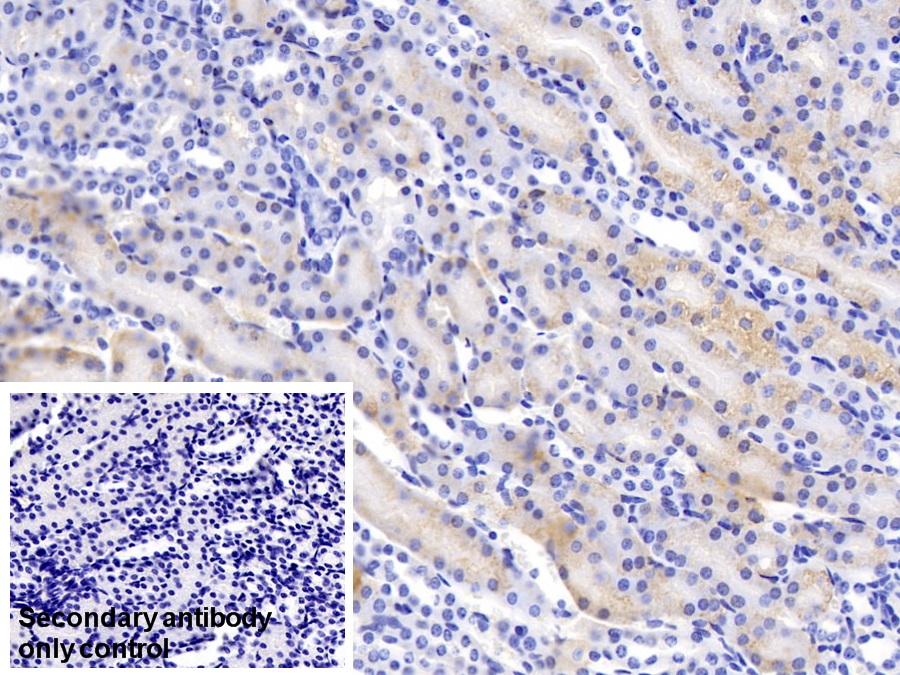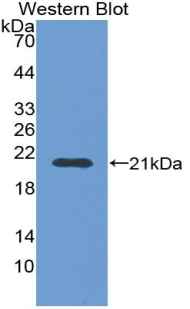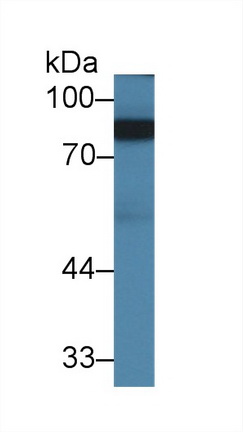Polyclonal Antibody to Amiloride Binding Protein 1 (ABP1) 

AOC1; DAO; KAO; Histaminase; Kidney amine oxidase; Diamine Oxidase; Amiloride-sensitive amine oxidase; Amine oxidase copper domain-containing protein 1
Overview
Properties
- Product No.PAA656Mu01
- Organism SpeciesMus musculus (Mouse) Same name, Different species.
- ApplicationsWB; IHC
If the antibody is used in flow cytometry, please check FCM antibodies.
Research use only - DownloadInstruction Manual
- CategoryEnzyme & Kinase
- SourcePolyclonal antibody preparation, Host Rabbit
- Ig Type IgG, Potency n/a
- PurificationAntigen-specific affinity chromatography followed by Protein A affinity chromatography
- LabelNone
- Immunogen RPA656Mu01-Recombinant Amiloride Binding Protein 1 (ABP1)
- Buffer FormulationPBS, pH7.4, containing 0.02% NaN3, 50% glycerol.
- TraitsLiquid, Concentration 0.5mg/mL
Sign into your account
Share a new citation as an author
Upload your experimental result
Review

Contact us
Please fill in the blank.
Specifity
The antibody is a rabbit polyclonal antibody raised against ABP1. It has been selected for its ability to recognize ABP1 in immunohistochemical staining and western blotting.
Usage
Western blotting: 0.01-2µg/mL;
Immunohistochemistry: 5-20µg/mL;
Optimal working dilutions must be determined by end user.
Storage
Store at 4°C for frequent use. Stored at -20°C in a manual defrost freezer for two year without detectable loss of activity. Avoid repeated freeze-thaw cycles.
Stability
The thermal stability is described by the loss rate. The loss rate was determined by accelerated thermal degradation test, that is, incubate the protein at 37°C for 48h, and no obvious degradation and precipitation were observed. The loss rate is less than 5% within the expiration date under appropriate storage condition.
Giveaways
Increment services
-
 Antibody Labeling Customized Service
Antibody Labeling Customized Service
-
 Protein A/G Purification Column
Protein A/G Purification Column
-
 Staining Solution for Cells and Tissue
Staining Solution for Cells and Tissue
-
 Positive Control for Antibody
Positive Control for Antibody
-
 Tissue/Sections Customized Service
Tissue/Sections Customized Service
-
 Phosphorylated Antibody Customized Service
Phosphorylated Antibody Customized Service
-
 Western Blot (WB) Experiment Service
Western Blot (WB) Experiment Service
-
 Immunohistochemistry (IHC) Experiment Service
Immunohistochemistry (IHC) Experiment Service
-
 Immunocytochemistry (ICC) Experiment Service
Immunocytochemistry (ICC) Experiment Service
-
 Flow Cytometry (FCM) Experiment Service
Flow Cytometry (FCM) Experiment Service
-
 Immunoprecipitation (IP) Experiment Service
Immunoprecipitation (IP) Experiment Service
-
 Immunofluorescence (IF) Experiment Service
Immunofluorescence (IF) Experiment Service
-
 Buffer
Buffer
-
 DAB Chromogen Kit
DAB Chromogen Kit
-
 SABC Kit
SABC Kit
-
 Long-arm Biotin Labeling Kit
Long-arm Biotin Labeling Kit
-
 Real Time PCR Experimental Service
Real Time PCR Experimental Service
Citations
- Effects of copper-exchanged montmorillonite, as alternative to antibiotic, on diarrhea, intestinal permeability and proinflammatory cytokine of weanling pigsCas.zju: Source
- A multi-component herbal preparation, STW 5, shows anti-apoptotic effects in radiation induced intestinal mucositis in ratsPubmed:25022208
- Elevation of HO-1 Expression Mitigates Intestinal Ischemia-Reperfusion Injury and Restores Tight Junction Function in a Rat Liver Transplantation ModelPubMed: 26064429
- Early prediction of intestinal mucosal barrier function impairment by elevated serum procalcitonin in rats with severe acute pancreatitis.Pubmed:26804005
- Modulation of gut microbiota contributes to curcumin-mediated attenuation of hepatic steatosis in ratspubmed:28341485
- A DPP-IV-resistant glucagon-like peptide-2 dimer with enhanced activity against radiation-induced intestinal injurypubmed:28522195
- Serum Diamine Oxidase in Pseudoallergy in the Pediatric Populationpubmed:28804811
- Protective effect of aplysin on liver tissue and the gut microbiota in alcohol-fed ratspubmed:28622357
- Protective Effect of Aplysin Supplementation on Intestinal Permeability and Microbiota in Rats Treated with Ethanol and IronPubmed:29861488
- Pregnancy-associated diamine oxidase originates from extravillous trophoblasts and is decreased in early-onset preeclampsiaPubmed:29679053
- Postoperative symbiotic in patients with head and neck cancer: a double-blind randomised trialPubmed:29277158
- The effect of fucoidan on intestinal flora and intestinal barrier function in rats with breast cancerPubmed:29384543
- LOCALIZATION OF COPPER-CONTAINING AMINE OXIDASE ENZYMES IN THE BLOOD
- Effects of fecal microbiota transplantation and joint application of probiotics on rats with alcoholic liver disease
- Potent anti-inflammatory activity of polysaccharides extracted from Blidingia minima and their effect in a mouse model of inflammatory bowel disease
- Modulation of gut microbiota contributes to effects of intensive insulin therapy on intestinal morphological alteration in high-fat-diet-treated micePubmed: 31749050
- Liraglutide Attenuates Nonalcoholic Fatty Liver Disease by Modulating Gut Microbiota in Rats Administered a High-Fat DietPubmed: 32149099
- HMGB1‐associated necroptosis and Kupffer cells M1 polarization underlies remote liver injury induced by intestinal ischemia/reperfusion in ratsPubmed: 31961020
- The effect of Poria cocos ethanol extract on the intestinal barrier function and intestinal microbiota in mice with breast cancerPubmed: 33039631
- Fecal microbiota transplantation from patients with autoimmune encephalitis modulates Th17 response and relevant behaviors in micePubmed: 32821439
- Effects of fucoidan on tumor prevention and gut flora
- Design and development of novel fasudil derivatives as potent anti‐breast cancer agent that improves intestinal flora and intestinal barrier function in rats34587363
- Bovine lactoferricin ameliorates intestinal inflammation and mucosal barrier lesions in colitis through NF-κB/NLRP3 signaling pathways
- Transplanted hair follicle mesenchymal stem cells alleviated small intestinal ischaemia–reperfusion injury via intrinsic and paracrine mechanisms in a rat model








